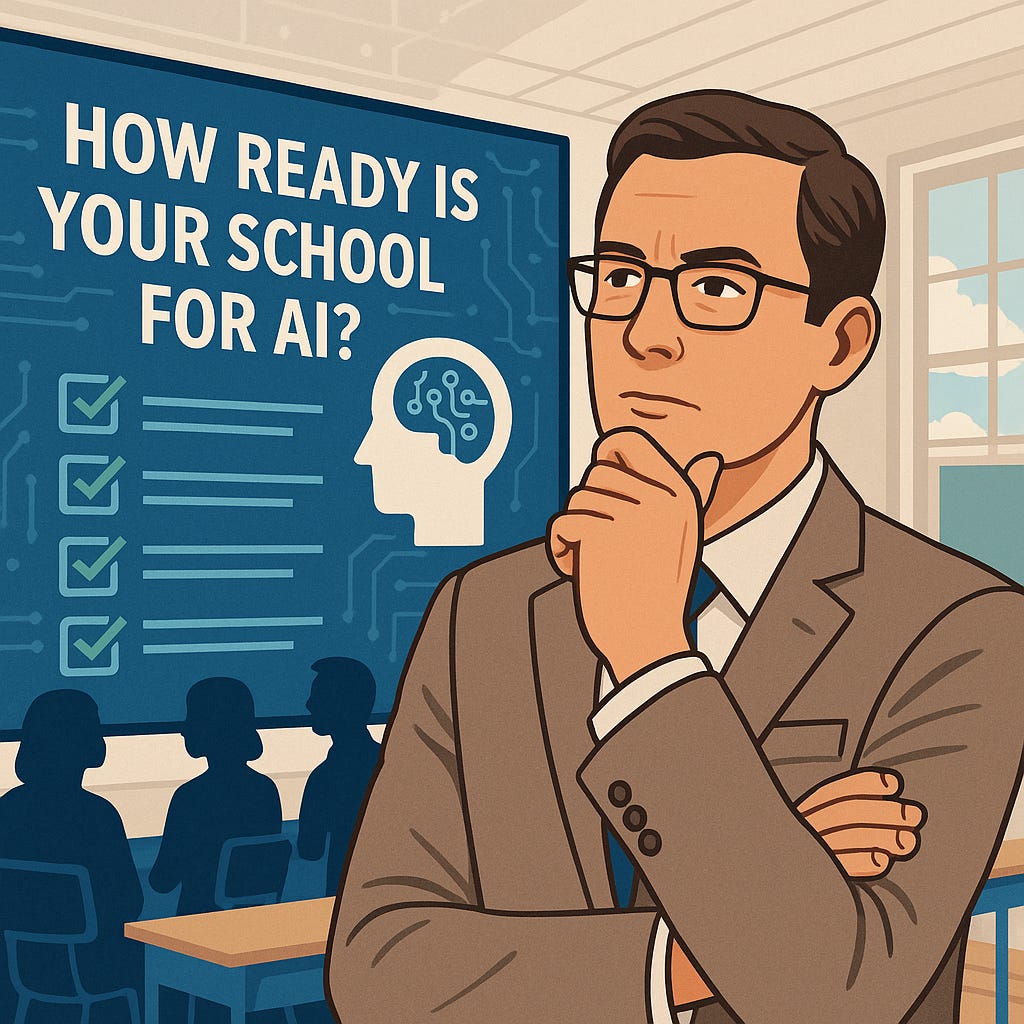How Ready Is Your School for AI? A Leadership Reflection
We don’t need all the answers to start. But we do need the right questions.
This post is part of a series exploring how schools can integrate AI meaningfully, ethically and strategically. It offers insights and strategies for educators across all curricula and contexts — from Dubai to Dublin, Delhi to Durban and everywhere in between.
Subscribers receive exclusive access to planning tools, audit templates and CPD resources throughout the orientation section of this series.
Why readiness matters more than resources
There is growing pressure on school leaders to "do something" with AI. Mandates, inspections and increased curiosity from parents all demand action. But true AI readiness is not about delivering one assembly or writing a quick policy. It is about clarity, consistency and culture.
The good news? Readiness does not require perfection. It starts with reflection and a clear plan to grow.
What AI readiness looks like in real schools
You do not need advanced tools or a huge tech budget to be ready. Readiness shows up in your school's thinking, systems and professional conversations:
Leadership openness: Leaders are curious, cautious and transparent. They are asking questions and involving their teams in the process.
Shared vocabulary: Staff understand and use key terms like prompting, bias and automation with growing confidence.
Teacher agency: Teachers feel supported to explore and adapt, with no fear of getting it wrong.
Student voice: Students are discussing AI in authentic ways, in debates, reflections, projects and personal choices.
Parent communication: Families are informed and involved. AI is not treated as a behind-the-scenes topic.
Ethics and inclusion: AI is framed through human values, not just innovation or efficiency.
All of this can happen before your school even adopts a single AI tool.
Five reflection questions for leadership teams
Use these questions in your next SLT, phase or department meeting. They are also available as printable slides and tools for subscribers.
Clarity: Do we have a shared understanding of what AI is and is not across the staff?
Consistency: Are we delivering clear and aligned messages to students and parents about AI use?
Confidence: Are we giving teachers time, trust and space to learn and grow their AI awareness?
Ethics: Have we opened honest discussions about fairness, bias and inclusivity?
Capacity: Do we know where our staff are starting from and are we ready to support that journey?
You do not need all the answers. You just need a starting point.
What schools are already doing
Here are two real examples of readiness in action:
An international school asked departments to complete an AI readiness grid. They reviewed teacher use, student access, key communication messages and emerging concerns. This directly informed a tiered CPD programme with pathways for emerging, growing and confident AI users.
Another school used a whole-staff session to co-create a "musts and maybes" matrix. Staff agreed on non-negotiables such as academic honesty and explored flexible areas such as using AI for planning support or formative quizzes.
These steps show that AI implementation is a shared effort, not a top-down directive.
What AI readiness is not
❌ A one-off staff meeting
❌ A generic assembly with no follow-up
❌ A policy written in isolation by one person
✔️ A culture of trust, clarity and inclusion
✔️ Shared understanding and consistent language
✔️ Conversations that build confidence over time
Three next steps for school leaders
Here are three actions you can take this week:
Start a reflective conversation: Use the five questions above with your team. Honest dialogue is the most powerful first step.
Draft a shared expectations matrix: Invite your staff to co-create a "musts and maybes" list for AI in your setting.
Communicate with your wider community: Use the templates and tips in Post 3 to strengthen parent and student conversations.
Subscribers have access to the full orientation resource pack, including audit tools, presentation slides and sample policies.
🔗 Useful Links
OECD – Skill Needs and Policies in the Age of Artificial Intelligence
A practical overview of how education systems can respond to AI skill demands.
Read the reportCommon Sense Media – AI Parent Guide
A clear, practical introduction to AI for families and educators.
Visit the guide
🧠 Reflective questions for your setting
Are we equipping staff to have the right conversations, not just deliver the right tools?
Where does our school sit on the readiness journey and what is our next step?
How do we ensure that our values lead the way, not just our technology?
AI in Education Blog Series – Full List
This 4-week series explores how schools can embed AI meaningfully, ethically and strategically across curriculum, CPD, leadership and inclusion. New posts are published four times a week throughout June and July 2025.
Week 1: Orientation – Understanding the Shift
How to Talk to Students About AI (Even When You’re Not an Expert)
Bridging the Gap: What Parents and Teachers Need to Understand About AI
How Ready Is Your School for AI? A Leadership Reflection (You are here)
Week 2: Teaching, Equity and Ethics
Planning with AI Without Losing Professional Judgement
Can We Really Teach Ethics in AI? Yes – Here’s How
What Inclusive AI Use Looks Like in EAL and SEND Contexts
Keeping Students Safe: The New Rules of AI and Safeguarding
Week 3: Teaching Across Subjects
Reimagining Reading and Writing: AI in English and Arabic
AI in Math and Science: From Calculation to Simulation
What Happens to Critical Thinking When AI Can Summarise?
Creativity and Authenticity in the Age of AI
Week 4: Strategy, Assessment and Future Readiness
What Every School Needs Before Saying “We Use AI”
Why CPD on AI Should Start with Questions, Not Tools
What Does “AI Literacy” Really Mean, and How Do We Know Students Are Gaining It?
From Pilot to Policy: Embedding AI in the School Development Plan




